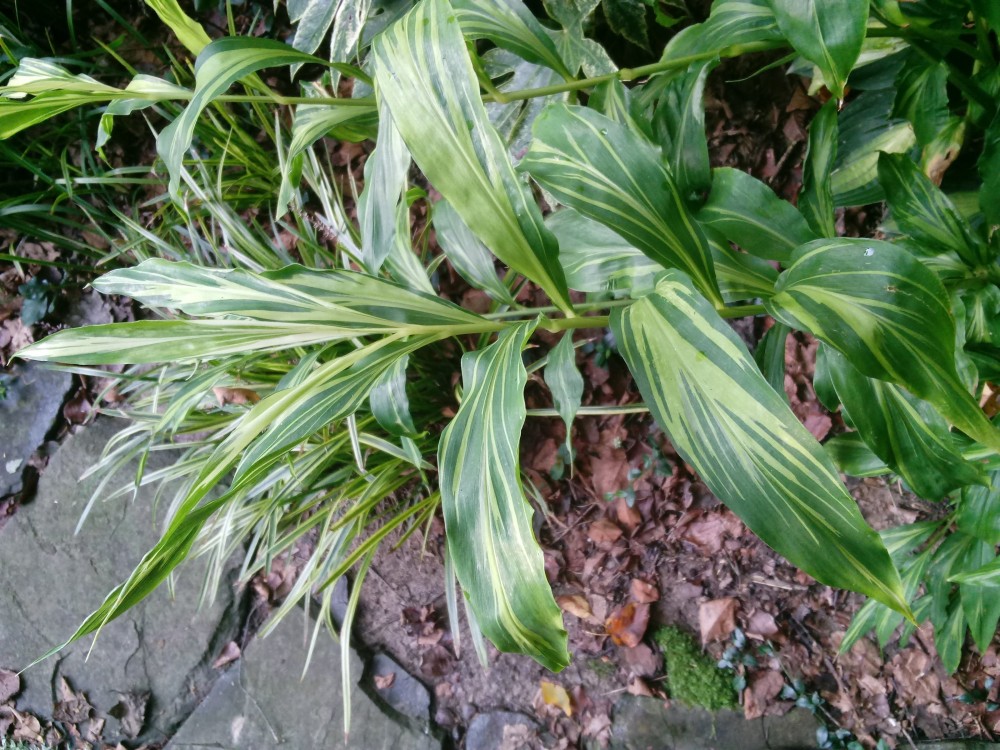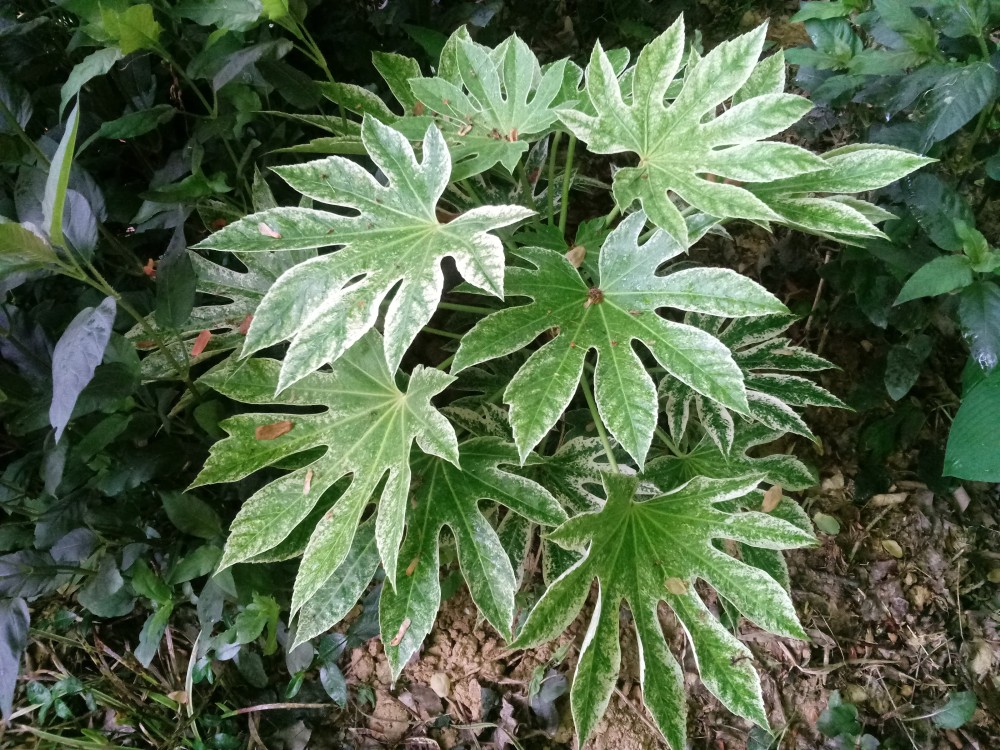Flowers of the hardy ginger (Zingiber mioga ‘Dancing Crane’, below) are not particularly ornamental, even when they can be seen, which is only when the arching stems are lifted and the gardener bends nose down from his knees. The flowers are perhaps an inch above the soil, not seen without effort, and who would know when they are in bloom except by chance, or by keeping a calendar of such events. I fall into the “by chance” category, though I was somewhat aware that flowering was somewhere around this time.
Presumably, there is some mechanism for pollinators to find the flowers. For the gardener, this is a rather insignificant curiosity, though the foliage has a tropical appeal and the ginger’s slow spread beneath the ground affords a moderate number of transplants to spread around the garden, or to share with acquaintances.
The variegated foliage of ‘Dancing Crane’ (below) is reason enough to grow this ginger without regard for flowers, and even occasional stems with only green leaves are attractive, though I would not have been tempted to make the initial purchase if not for the variegation. I recall my skepticism at first that this ginger could possibly be cold hardy, and it is very late to break ground in the spring. But, after winters when temperatures have dropped to five and six below zero, I am now confident that ‘Dancing Crane’ will return annually.
I presume that the area where it is planted would be classified as part shade, and now I have split several transplants into sunnier and shadier spots to put the ginger to the test. I suspect it will survive in all exposures. I’ve avoided areas of the driest shade where roots run along the surface, so in deeper soils I look forward to new clumps that will allow additional sharing. Certainly, I should have no problem finding takers, despite the lack of obvious flowers.
It suddenly occurs to me that despite temperatures in the mid eighties this week, there could be frost and even a freeze any time now that we’re into October, though recent history tells us that it is more likely in early November. Four variegated fatsias (Fatsia japonica ‘Spider’s Web’, below) were planted in early spring with the intention that two would be left outdoors for the winter to test their hardiness, and two would be dug to bring indoors so that at least I have something if winter temperatures are severe. I’ve long presumed fatsia to be a plant that must be brought indoors for the winter, and I’ll be surprised if it holds up like it’s supposed to.
Fatsias are rated as cold hardy to zero, but I’ve heard this song before, with plants predictably dead before the coldest days of our winters. In recent years, every cold hardy gardenia in the garden perished, so I have little faith in published hardiness ratings, But, I hear reports of success with fatsias in areas slightly colder than here, so there’s hope. Still, I am leaning in the direction of chickening out to fill a cage of rabbit wire with leaves for cold protection. This defeats the purpose of the trial, but the objective is to have live plants come spring.
Dear Dave, good point about the pollinators! Where do you store the plants you bring indoors for the winter? Do they get enough light in a garage, for example? Thanks as always for the lovely pics and great posts! 😀
Double glass doors in the basement provide some light, and several LED lights keep them alive.
Hi Dave, Good luck with your fatsia japonica. Here on the south coast of the UK I’ve kept one permanently outdoors for about 3 years now. We’re in a relatively mild area but we do get a few sub zero temperatures, especially overnight, and this year we had a few days of snow all of which it has survived so far.
In Virginia, USA, below zero is Fahrenheit, a bit colder than zero in Celsius. Still, fatsia is rated to zero degrees Fahrenheit, though often plants with variegated foliage have less tolerance. This garden sits in the shadow of forest, between foothills that soon rise to become the Blue Ridge Mountains, so while the garden is protected from winter winds, cold settles into the low point between mounds so that snow melts weeks later than on neighboring properties.
Ah yes, I forgot about the Fahrenheit / Celcius difference – brrrr!
Dang! I would have been skeptical too! They grow here, but I would not have thought to try them in cooler climates. I still think of them as ginger like those that grow in Southern California. There are a few to grow here, but they at least look less tropical.
I believe that Fatsia japonica is surprisingly tolerant to frost. If I remember correctly, It grows at my Pa’s farm in Poulsbo in Washington.